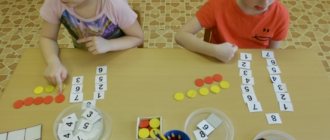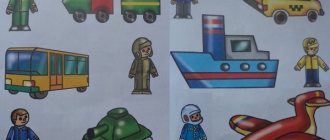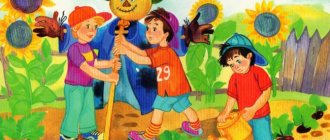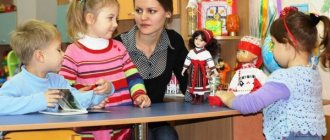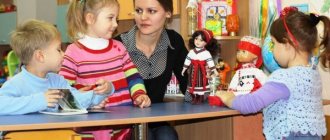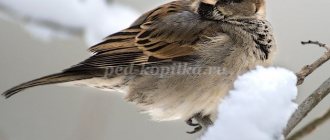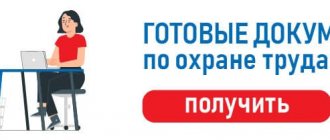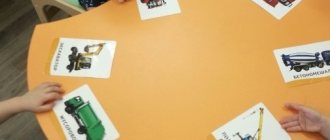The emphasis in modern education of preschool children is on developmental education. Math classes are no exception. The formation of elementary mathematical concepts develops personality, intelligence, logic and abstract thinking. It sharpens attention and memory, develops speech and promotes the most comfortable integration of the baby into the world around him. Fun math for children 3-4 years old will help develop qualities such as curiosity, goal achievement, and discipline. Introduces spatial and temporal logic.
What does mathematics teach 3-4 year old children?
Every educated parent wants to understand how well their child is developed. Are you missing any skills that are important in the modern world that you should focus on? To adequately assess children's knowledge and skills, you need to know what today's education system requires of them.
Mathematics for three-year-old children
Mathematics at 3 years old in kindergarten is not difficult. Children should:
- Master working with numbers within five. This is both an ordinal and a reverse count.
- Understand what this or that number consists of (for example, 5 is 4+1).
- When counting, use fingers, counting sticks, and other available objects.
- Correctly use the names of ordinal numbers, as well as cardinal numbers in the names of numbers.
- Recognize written numbers and be able to write them yourself.
- Name the number that comes before the given one, as well as after it.
- Use the terms “more”, “less”, “the same”. Clearly understand the difference between them.
- Master orientation in space (for example, show on a piece of notebook where the lines are higher and lower, which are on the left, right, between them, what is in the center, what is above, what is below).
For your information! Children must distinguish objects.
By size:
- Big bigger.
- Small - less.
- Short - shorter.
- Long - longer.
- Tall - higher.
- Low - lower.
- Wide - wider.
- Narrow - narrower.
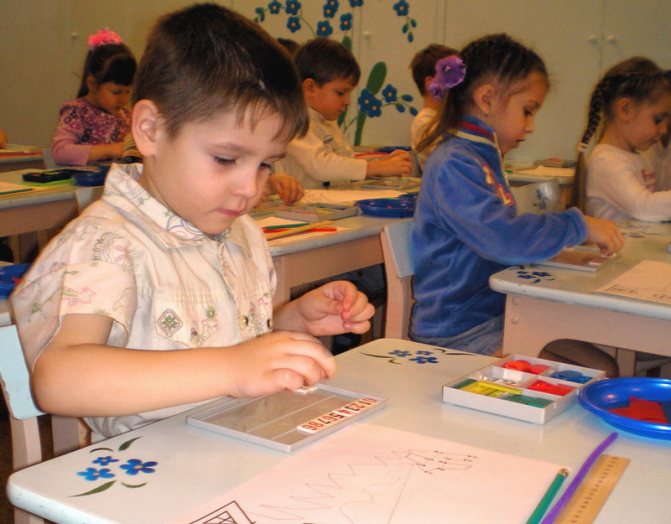
Math classes
By geometric shape:
- square;
- circle;
- triangle;
- rectangle.
They must find these figures and be able to draw them, name the geometric shape of surrounding objects. Learn to identify their color. Distinguish between a circle and a ball, a square and a cube.
Didactic games for mathematical development
The presented card index of didactic games in mathematics is recommended for preschool teachers and parents. During classes, preschoolers become familiar with counting, learn to work with numbers and geometric shapes, compare, contrast, and list.
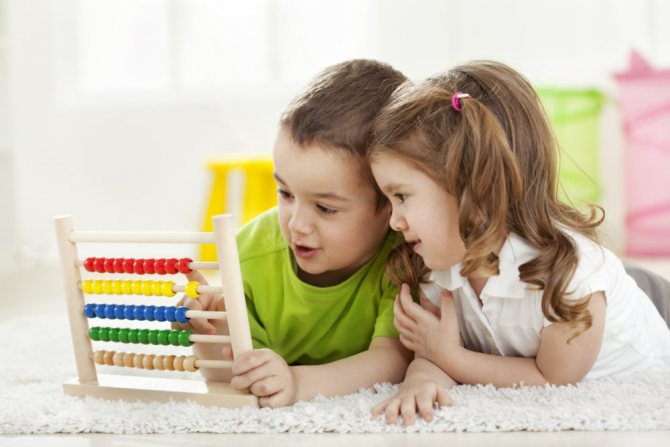
Objectives of the games presented in the catalog:
- gaining skill in using numbers;
- improving the ability to count and distribute numerical values;
- familiarity with numerical and conceptual designations of time, days, months;
- development of spatial and planar orientation, the ability to determine and explain the location of objects relative to each other;
- expansion of ideas about geometric shapes;
- development of memory, ability to think logically, reason, analyze, make assumptions, sum up, concentrate attention;
- development of creative thinking and imagination.
Counting and numbering numbers
The teacher’s task is to understand whether children understand the ultimate purpose of counting and why they are doing it.
Mathematics for children aged 3-4 years has its own characteristics. It is necessary to direct their attention to the study of a serious subject. For this purpose, all kinds of auxiliary materials and presentations are used.
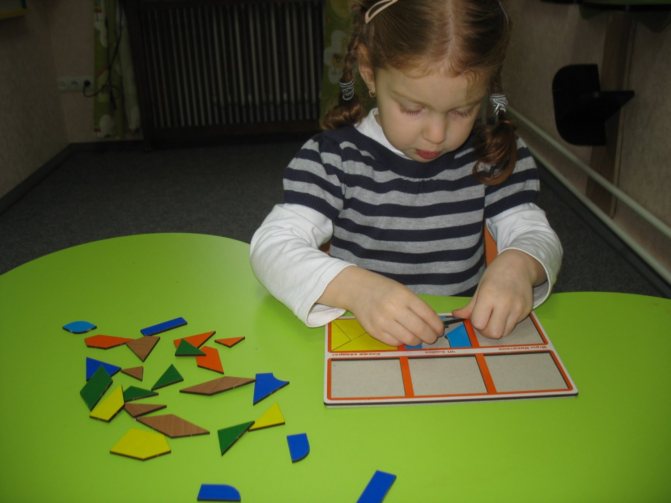
Studying figures in preschool educational institutions
Fairy tales, toys, cubes, pictures (characters from fairy tales and cartoons printed on a color printer will be excellent handouts), lapbooks will also come in handy. They are easy enough to make yourself.
Children must master the names of numbers. But often they do not project this knowledge onto what concerns them. For example, a child knows ordinal counting perfectly, but cannot count his fingers. He simply doesn't connect the two.
Important! The teacher’s task is not only to give the concept of numbering and counting, but also to connect these things with the real world in the child’s mind.
Card index of topics for conversations in the senior group and for situational conversation
Didactic games in mathematics for the senior group
We present educational games suitable for the older age group of kindergarten.
Aircraft
The game introduces the composition of the number 10. The flannelgraph acts as an airfield. Images of airplanes are attached to it. One of the students becomes a dispatcher: he sends one plane at a time and removes the flannelgraph. The rest of the players count how many planes have flown away and how many remain at the airfield.
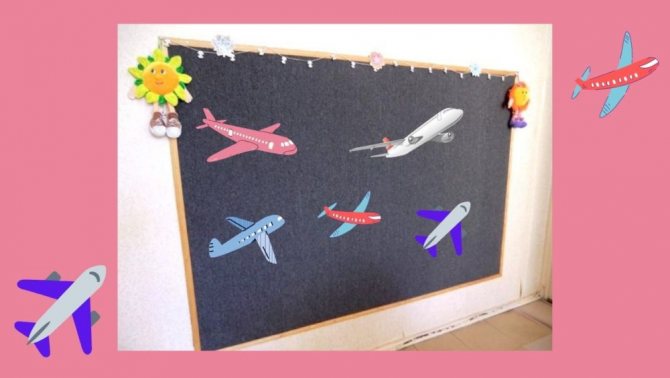
Fun geometry
To play you need counting sticks. Children fold them so that geometric shapes emerge:
- 3 identical squares of 10 sticks;
- 2 identical squares out of 7;
- 2 identical triangles out of 5;
- 3 identical triangles out of 7;
- 4 identical triangles out of 9;
- one square and 2 identical triangles out of 5;
- one square and 4 triangles out of 9;
- 2 squares and 4 identical triangles out of 9.
In the last task you need to make squares from 7 sticks, then use the remaining 2 sticks to break them into triangles.
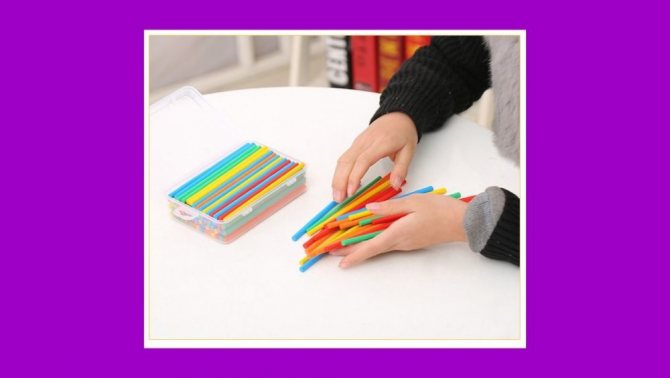
What happens?
The purpose of the didactic game in mathematics is to develop ideas about basic subject quantities and develop the skill of determining similarities in size.
The teacher names an adjective that defines a quantity, throws the ball to the players one by one, and they must name the objects that correspond to the specified definition. For example: "Tall". Children list: “Giraffe, closet, house, man, mountain.” Similarly for other definitions: long, narrow, short, low, large, small, wide.
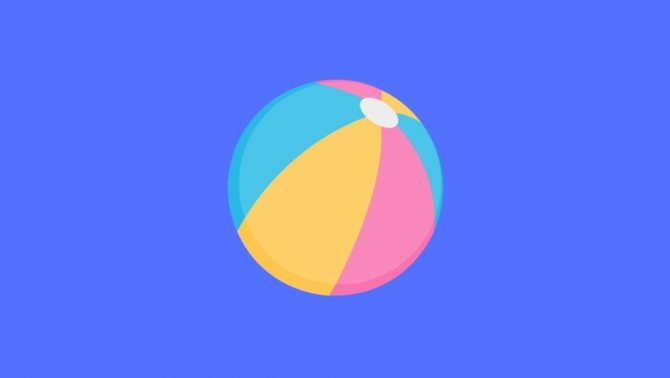
Months
To play, you need cards depicting numbers from 1 to 12. Children sort the cards without looking. Then they stand in a row according to the numbers received. The teacher says that now the children have become the 12 months of the year. Then he asks questions of this type: “Third month, what is your name? April, what number are you?”
At the second stage of the game, the teacher lays out pictures on the table depicting seasonal landscapes and phenomena corresponding to the months. Players look at the pictures and find an image that matches their month.
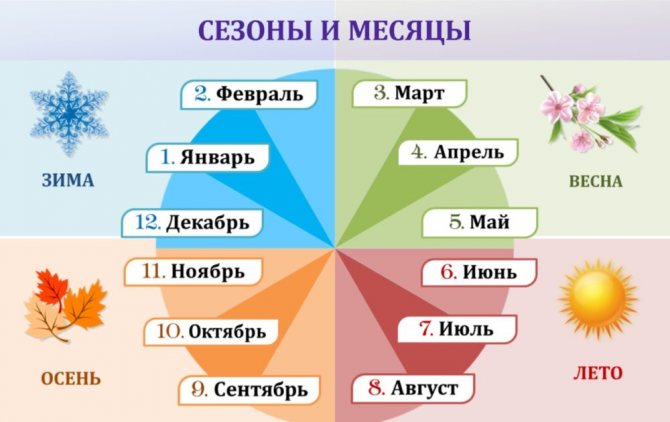
Count by touch
To play, you need cardboard strips with beads sewn to them in quantities from 2 to 10. Players stand in a row, put their hands behind their backs, and receive strips from the teacher. Hands remain behind your back; you cannot look at the stripes. The game task is to count the number of beads.
The teacher names an arbitrary number, for example, 3. The child, who has counted the same number of beads, raises his hand and shows everyone the strip. Then the teacher changes the players' stripes and the game continues.
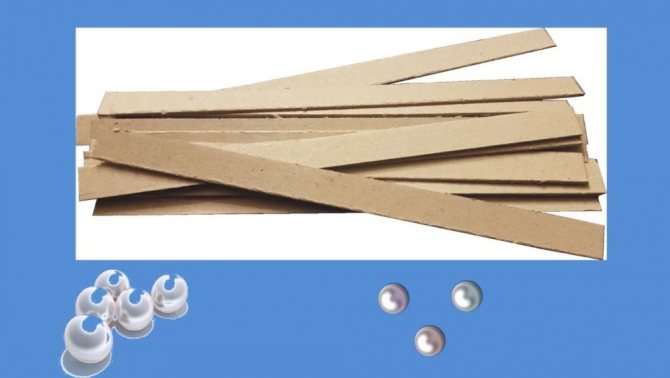
When does this happen?
The game reinforces the idea of the time periods of the day, what one should do at different times. For the lesson, you need to prepare a large image of a clock with a moving hand, as well as pictures that show what people are doing at different times of the day. The teacher moves the arrow for a certain time, and the children choose the corresponding picture. For example, when the hand is moved to the hour, children choose a picture of a family having dinner.
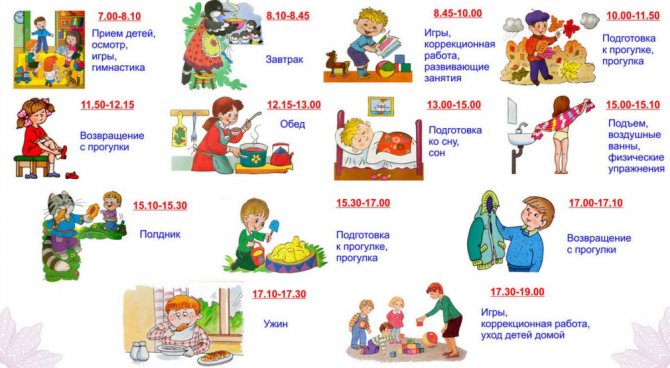
Compare tapes
The game trains the skill of comparison based on external parameters. For this lesson you need 7 ribbons, varying in width and length.
Having laid out the tapes, the teacher asks the children:
- how many ribbons are there;
- are they the same or different;
- which ribbon is the longest, shortest, narrowest, widest;
- arrange the ribbons, starting from the shortest, ending with the longest;
- where in the resulting row is the widest ribbon, and where is the narrowest;
- arrange the ribbons from narrowest to widest;
- where in the resulting row is the longest ribbon, and where is the shortest.
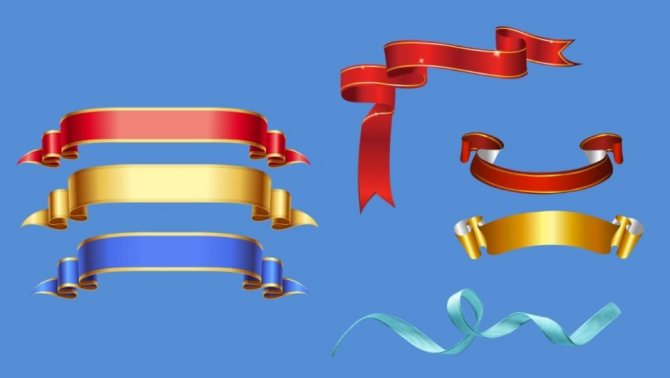
Count the sounds of the orchestra
To play, you need musical instruments familiar to preschoolers that you can knock on: a drum, a tambourine, a triangle, a toy synthesizer. First, the teacher demonstrates to the students how the instruments sound, then hides them behind a screen. There, the teacher again hits a certain instrument 2-5 times, and the children must say what it sounded like and how many hits they heard. The game can be made more difficult by hitting 2-4 instruments at a time.
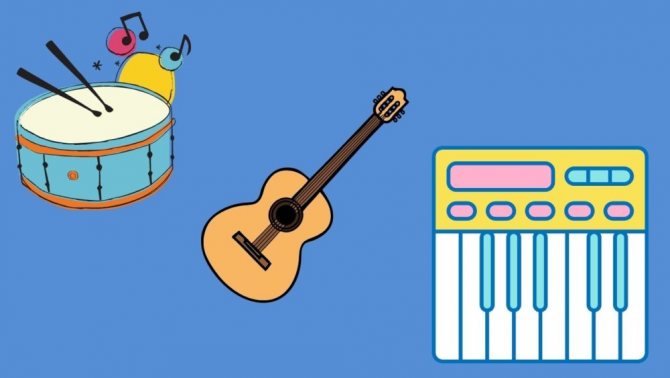
Let's treat ourselves to fruit
The game teaches division into different-sized parts and expands thematic vocabulary. The teacher brings fruit, for example peaches. He complains that there is not enough food for everyone. He asks what to do so that everyone gets a piece of peach. Children advise: “Divide.” Next they explain how fruit is divided: “In half.” The teacher cuts the peaches. But there is still not enough food for everyone. Then the children advise: “You need to divide each half into two parts. It will turn out to be quarters.” Now everyone has enough food.
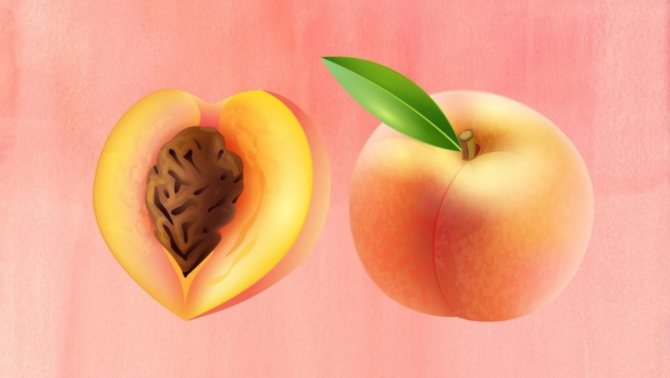
Math exercises
Additional material will be required for math classes. The preschool educational institution recommends “Igrachka” by L. G. Peterson. This teaching aid is intended for use in mathematics lessons for 3-year-olds in kindergarten. These notebooks can be purchased online. It is also recommended to use the technique of E.V. Kolesnikova.
Educational cards
Math for a 3-year-old child begins with pictures. Five cards are made with the numbers 1, 2, 3, 4, 5.
You need to prepare pictures of the same color, but different objects. For example:
- Blue color – car, ball, flower, umbrella, etc. (all the same color).
- Red color – car, ball, pencil, umbrella, etc.
- Yellow color – car, ball, ball, spoon, etc.
- Green color – car, ball, flower, umbrella, etc.
- Black color – car, ball, pencil, umbrella, etc.
- White color – car, ball, flower, umbrella, hare, etc.
This will gather a working presenter to study the initial account. The objects in the pictures must be of different sizes.
Tasks:
- Find all red cards. Find and name each picture.
- Find all yellow cards. Find and name each picture.
- Find all blue cards. Find and name each picture.
- Find all green cards. Find and name each picture.
- Find all black cards. Find and name each picture.
- Find all white cards. Find and name each picture.
After the children have completed the task, you can move on to the next stage.
Further tasks become more difficult. You need to select all the cards where the car is drawn. All cards with a ball on them.
For your information! Having different colors is very confusing for children at first.
Comparison "More-less"
Mathematics for a 3-year-old child, which takes place in a preschool educational institution, includes the study of comparisons. The concepts of “more” and “less” are explained to children. A set of cards from previous lessons is used:
- Find all the cards with a ball on them. Then find all the cards where an umbrella is drawn. Compare the number of cards. Find which drawings there are more.
- Find all cards with a drawn flower. Then find all the cards with a drawn car. Find which pictures are smaller.
For clarity, you can put together a picture with a car and a flower. Which pictures will be left without a pair, those and more. The ones that ended earlier are smaller.
Studying the concept of “The same amount”
At the beginning of the lesson (if someone is celebrating their fourth birthday), the parents of the birthday boy brought cake and sweets. How to determine how much sweets each child needs without using numbers? Children express their suggestions.
The term “same” is introduced. The guys practice learning a new word. Problems with similar terms are solved:
- Also;
- equal quantity;
- the same.
Didactic games in mathematics for the middle group
We present games for middle group kindergarteners, covering a wide range of mathematical knowledge: arithmetic, geometric, logical.
Tell me the missing number
To play you need to prepare 10 cards. Each one depicts a circle with a specific number from 1 to 10. All images are of different colors.
The teacher lays out the cards in the correct sequence of numbers. Children carefully examine the images, making sure that not a single number is missing. Then they close their eyes, and the teacher hides one image. Having opened their eyes, children try to remember what color the circle disappeared, what number was depicted on it.
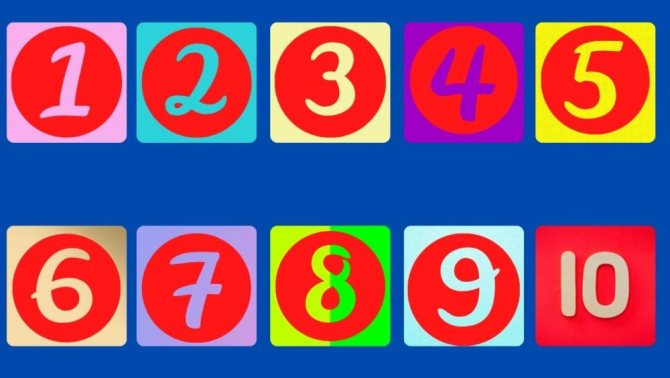
Count by sound
To play, you need cards depicting objects from 1 to 9. The teacher knocks on the tambourine a certain number of times, the children listen carefully and count the number of hits. Then select a card depicting the corresponding number of objects.
Math riddles
The game develops counting skills. The teacher posts several images of objects made in a certain quantity. Hand out drawn numbers to the children. Next, he reads out a riddle about one of the depicted objects, and the players guess it. For example: “I’m the size of a fist, red side, if you touch it it’s smooth, if you bite it it’s sweet.” Answer: "Apple." Children point to the picture, count how many apples there are on it, and raise the corresponding number.

Geometric designs
To play, you need to prepare images of 3 objects made from different geometric shapes: a house, a tree with Christmas balls, a snowman.
Children carefully look at the images, and the teacher asks questions:
- what figures are the drawings made from?
- are there any triangles here, count them;
- Are there squares, how many are there;
- if there are circles, count them;
- if there are any other figures, what kind and in what quantity;
- how many figures are there in the picture?
- the figures are the same or differ in size;
- what figures are there more?
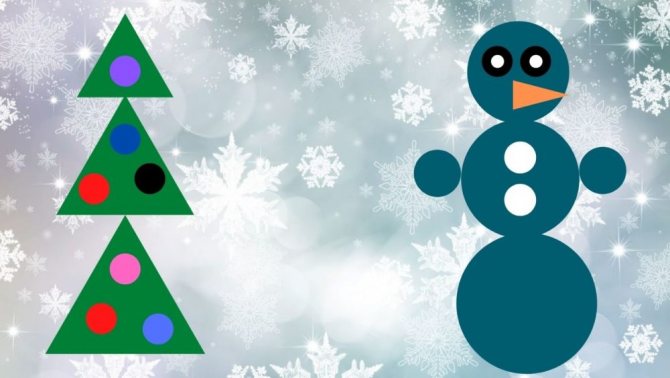
Let's fix the car
The game requires an image of a car made up of geometric shapes. One of the players becomes the leader, the rest of the children close their eyes. The presenter hides one of the figures that make up the car. Players, opening their eyes, must say what has disappeared. The first player to correctly name the missing part becomes the next leader. The game can be complicated: remove not one, but two pieces.
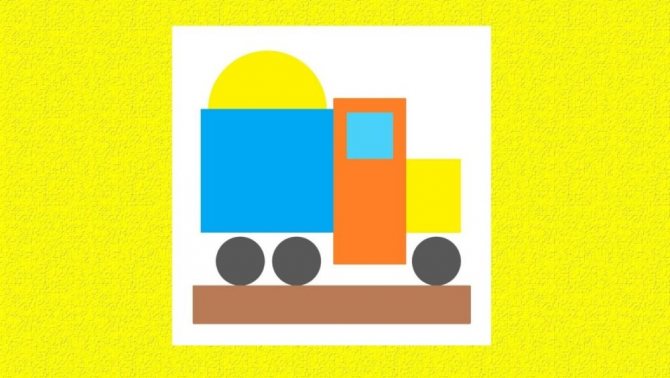
Find the mistake
The teacher arranges geometric shapes in a row according to certain characteristics. One of the objects does not correspond to the unifying feature. For example, all squares are green and one is blue. Or, in a row among the triangles there is a circle. The player must identify the error.
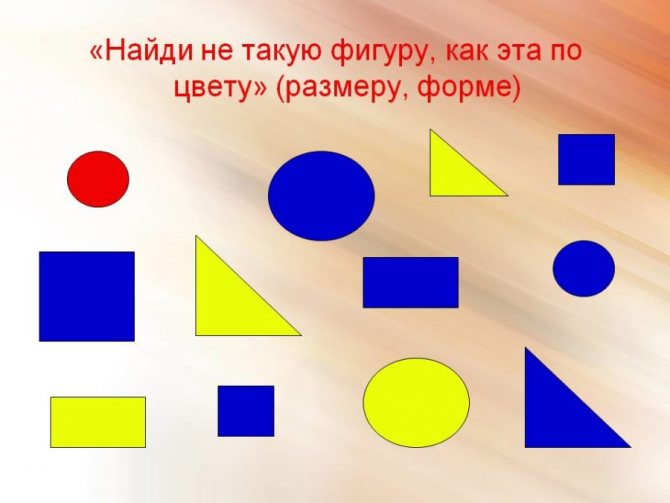
Magic bag
There are geometric shapes in an opaque linen bag. The player, plunging his hand inside, gropes for the object and names what it is. The game can be complicated: the teacher sets a certain figure, and the child tries to feel it and find it among the others.
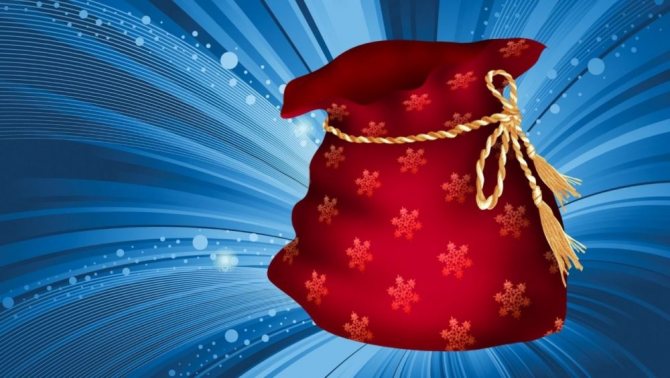
Adjacent digits
The players stand in a row. The presenter throws the ball to each child and names a number, for example 5. The task of the player who received the ball is to name the adjacent numbers. In this example it is 4 and 6.
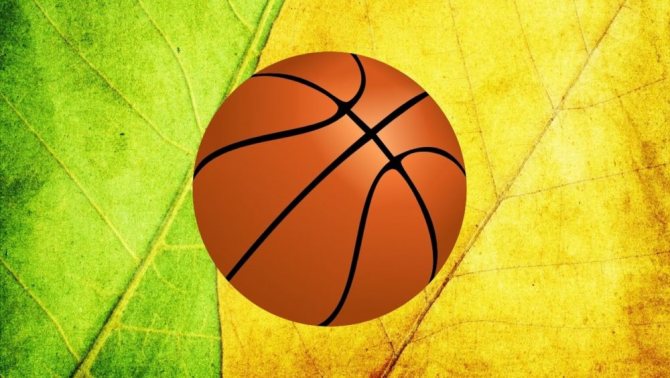
Kaleidoscope of squares
The game reinforces the idea of the relationship between parts and the whole and develops color perception. For the activity you need 36 paper squares 8x8 cm. The figures must be of different colors, and the shades must be clearly distinguishable. The squares need to be cut randomly. Write a number on the back of each piece.
Players complete the following tasks:
- put the pieces together into squares;
- distribute parts of figures by color;
- arrange the pieces according to numbers;
- They try to make squares from pieces that don’t match in color.
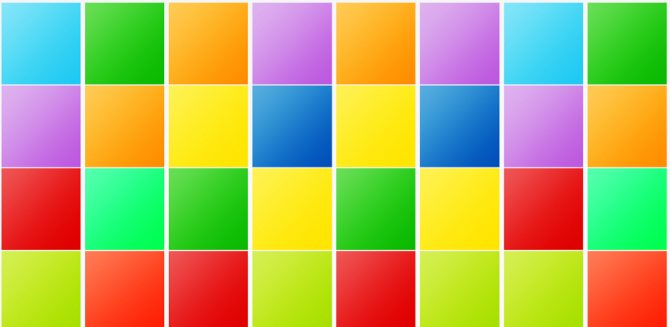
Describe the pattern
Each player receives an image consisting of different geometric shapes. The child must carefully examine his pattern and describe it in detail. For example: “There is an oval in the upper right corner, a circle in the upper left, a triangle in the lower right, a circle in the lower left, and a rectangle in the middle.”
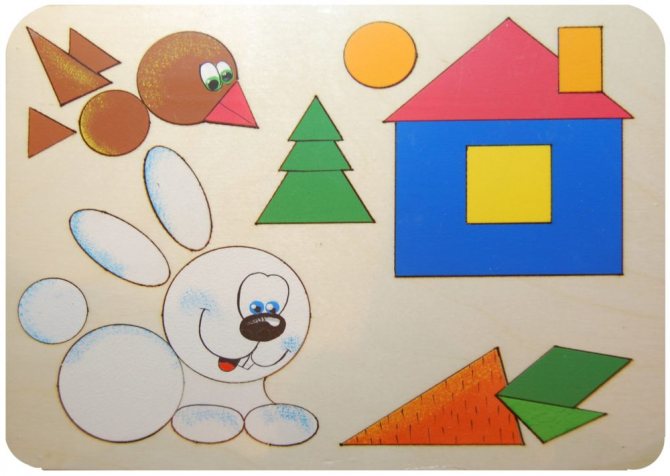
Matryoshka dolls
The game develops the skill of ordinal counting. For it you need to take 5 scarves of different colors and put them on the heads of the children standing in a row. The remaining players take turns taking part. The player approaches the nesting dolls, they call themselves: “first”, “second” ... “fifth”. The player remembers what number the nesting dolls with a certain color of scarf are located under, then turns away. Two people in a row change places. The player, turning back, must say what has changed. For example: “The matryoshka doll with a green scarf was second, now it’s fourth. And the nesting doll with a yellow scarf was fourth and became second.”
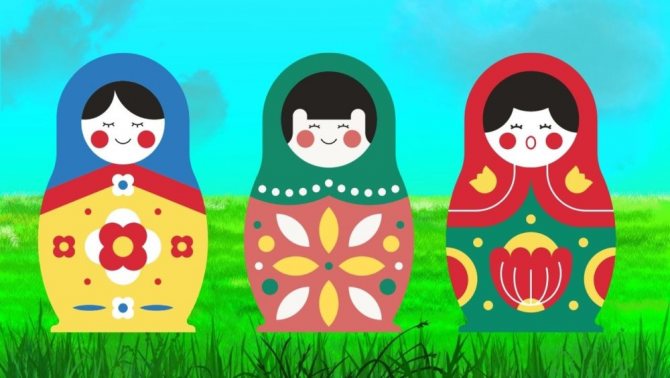
About counting on fingers
At the first stage of learning to count on fingers, you need to firmly grasp all possible combinations. The child should not think about the answer within one hand.
Lesson on life safety in the preparatory group according to the Federal State Educational Standard
Attentiveness and memory develop, including tactile memory, because counting takes place in the head. You have to hold several data in memory at the same time. A quick solution depends on intelligence and speed of perception.
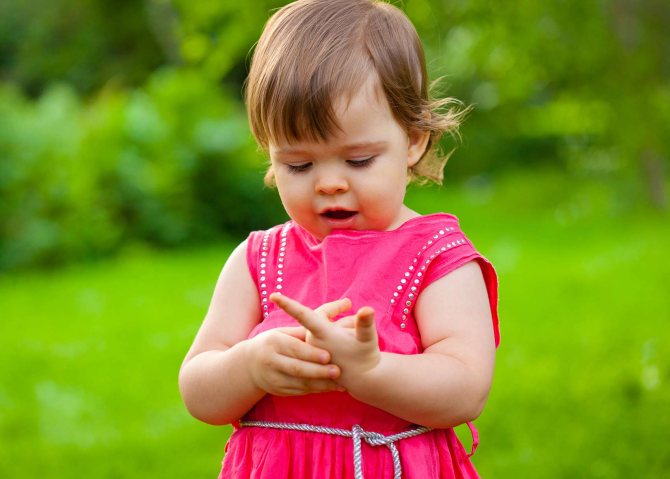
Child counts on fingers
Before learning to count on fingers, the child is already familiar with the concepts of “more,” “less,” and “also.” Can count objects in order within five.
Further:
- You need to start with 1+1=2. Children put two fingers together and get 2.
- Then add another finger = 3.
- Add one more to three and get the fourth result (four).
- Add one more finger to four and get five.
Now you can master subtraction:
- Subtract one finger from five and it becomes four.
- Subtract one finger from four and it becomes three.
- If you take away one finger from three, there will be two left.
- Subtract one finger from two and one remains.
The lesson should not exceed 20 minutes. Children get tired quickly. You can diversify the lesson by changing activities - warming up, singing something, solving riddles, and so on.
Important! You can't force it. It is always easier to “lure” someone somewhere than to force them. Elements of play, competition and reward will do more and better than anything else.
Didactic games in mathematics for the younger group
We present educational mathematical games that younger preschoolers can handle.
Find the figure
The teacher lays out 12 geometric shapes of different sizes and colors on the table in random order. He names an object with certain parameters, for example, a large green triangle, and the student must find this figure on the table and point at it with his finger.
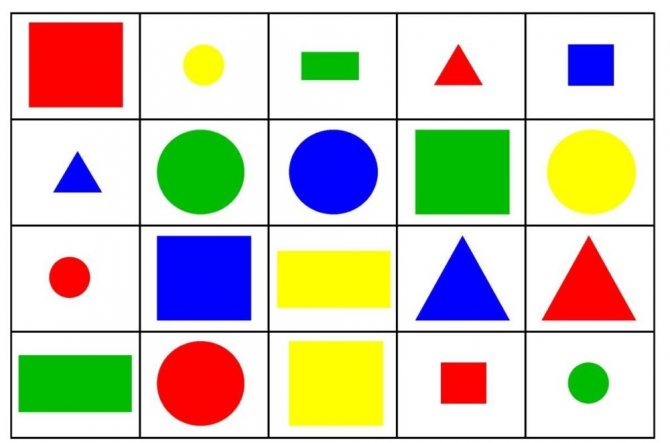
Geometric shapes around
The game expands your understanding of basic geometric objects. For the lesson, you need to prepare images of figures known to preschoolers. The players’ task is to find things in the playing area that are similar in outline to the figures on display.
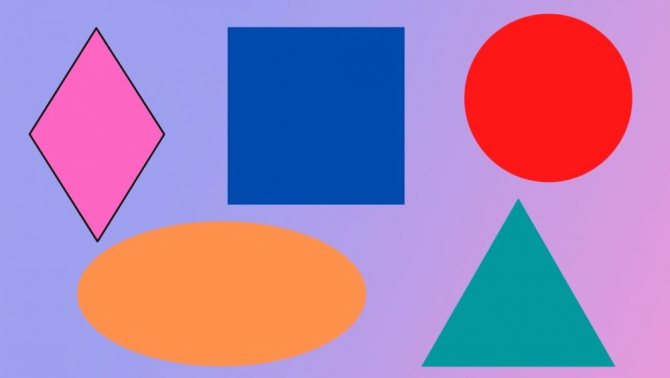
3 square
The game develops the skill of relating objects by size and consolidates the corresponding definitions in memory.
The teacher prepares 3 stacks of different sized squares. He takes 3 paper figures for himself, and distributes the remaining 3 pieces to the pupils. At the beginning of the game, the teacher one by one shows the squares to the children, while explaining the size of these figures: “This one is large, this one is medium, and this one is small.” Then he gives the commands: “Show me the smallest square. And now the big one. Show me the middle one." The children do it.
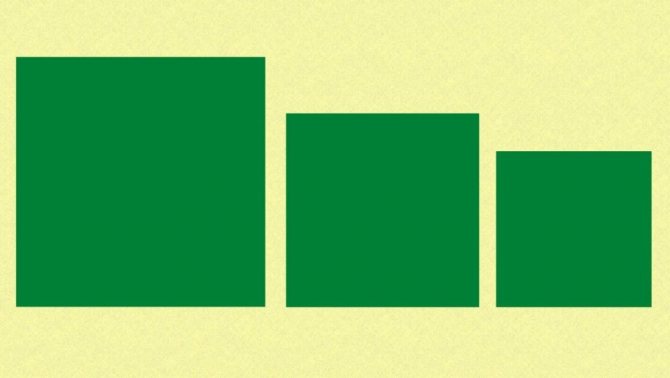
At the second stage of the game, the teacher tells that you can build a turret out of squares and shows how to do this. The large square should be at the bottom, the middle one is placed on it, and the small one becomes the top of the head. Pupils repeat after the teacher.
Treat the squirrels and bear cubs
The game teaches you to see whether groups of objects of different sizes are equal. Players develop the understanding that quantity is not determined by size.
The teacher places the toy animals in a row, explains that they supposedly came to visit, and first prepares images of forest treats: nuts for the squirrels, strawberries for the cubs. He asks the children if there are enough treats and asks how to find out. The players count how many toys came to visit and compare the quantities. Next, they give the animals a treat: they place the corresponding images next to them. If the number of treats turned out to be insufficient, children add as many as needed. If there are too many treats, the extra pictures are removed.
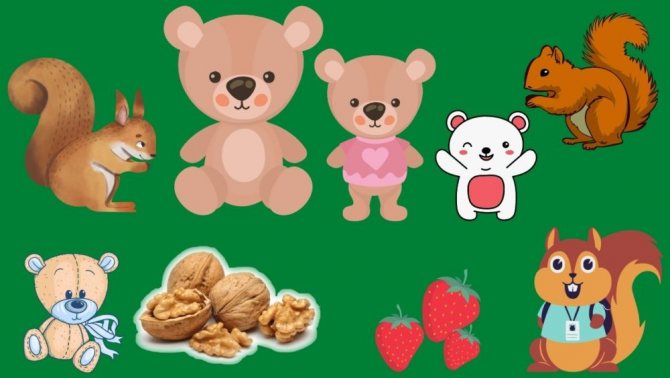
Call
The teacher arranges the counting sticks in two columns. One column should be larger in quantity than the other. The rest of the sticks are in the open box. The task is to use additional sticks to equalize the number of objects in the columns. After completing the task, the player must explain how he got this result.
Do-it-yourself didactic math games
To enhance the cognitive interest of preschoolers, it is recommended to create bright, varied and exciting material for games. It’s not difficult to make math games with your own hands, here are some interesting examples:
- Apples cut out of paper with different numbers of seeds - from 1 to 10. Children attach cards to them with the corresponding image of the numbers.
- Mathematical rosary - a cord with stringed beads. When solving an arithmetic example, the child moves the beads: counts the first number, then the second. And then he adds or subtracts and determines the resulting number of beads.
- Continue the series. The paper strips have different curved lines on them. At the beginning, geometric figures are glued along these strips in a certain sequence. The child’s task is to continue the row using additional figures from the box.
- Catch a fish. The paper buckets show numbers from 1 to 10. The fish show arithmetic examples. The preschooler solves the example, looks at which bucket shows the answer, and places the fish there.
- Cardboard sheets of a certain color have several different geometric holes cut into them. Geometric shapes are also cut out to match these holes in the shape and color of the sheet. The game task is to correctly place the pieces in the holes.
When making materials for games, you can use any available and natural means. The main thing is that they must be harmless to the child.
Didactic games in mathematics in the preparatory group
The preparatory group prepares preschoolers for entering school. Children already have a lot of knowledge, so games become more complex and provide the development of mathematical concepts sufficient for trouble-free learning in primary school.
Decorating the Christmas tree
The teacher attaches to the flannelgraph and also distributes to the pupils images of a Christmas tree and New Year's balls. He attaches 4 toys to the Christmas tree on the right side, 2 on the left. Children do the same with their Christmas trees. The teacher suggests adding up the balls: 4 + 2 = 6. Then he swaps the balls, it turns out 2 + 4 = 6. And so on several times with different numbers of toys. The game creates the idea that changing the terms does not change the sum.
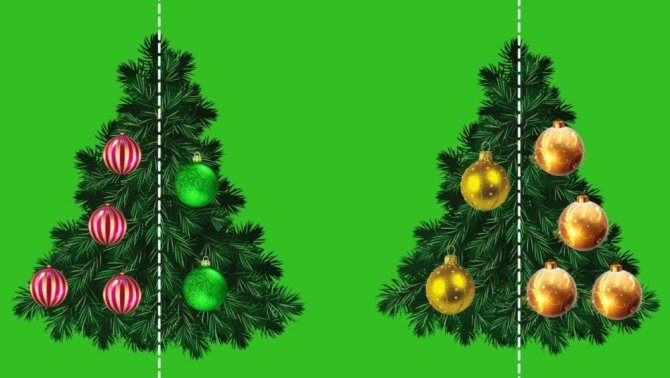
Path for Little Red Riding Hood
Attached to the flannelgraph are images of grandma's house, Little Red Riding Hood, and forest trees. Under each tree is a simple arithmetic example that a preschooler can handle. The students take turns approaching the flannelgraph, solving an example, thereby moving Little Red Riding Hood closer to grandma’s house.
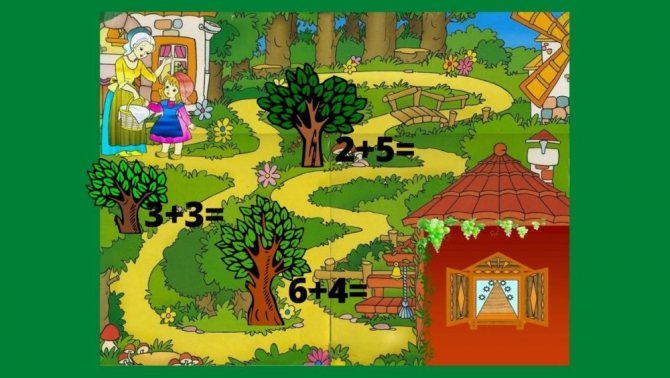
Yes or no
The teacher writes arithmetic examples on the board. Then shows the children pictures of numbers. If the number matches the solution to the next example, the children shout out: “Yes!” If the answer is wrong, they shout: “No!”
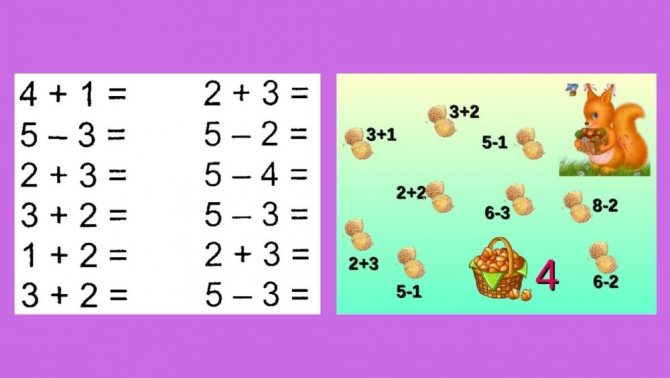
Make up a word
The game is competitive. The teacher displays arithmetic examples in two columns. Members of each team go out to solve them. The player who has solved the example approaches the table on which there are pictures of numbers corresponding to the solutions. He chooses his number, turns the picture over, and there is a letter there. Having solved all the examples, the team gets the floor. Those who complete the task faster win.
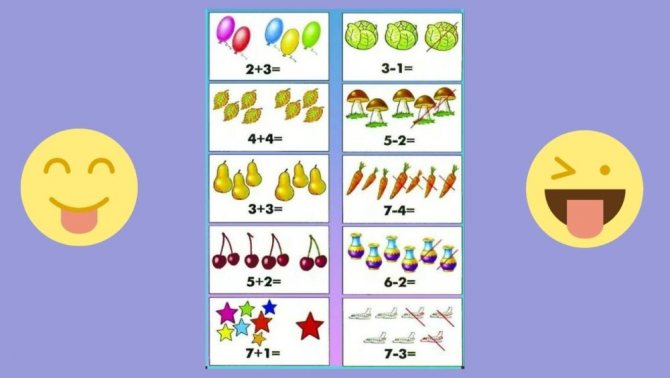
MAGAZINE Preschooler.RF
Mathematical development plays a huge role in mental education and in the development of a child’s intelligence. Mathematics has a unique developmental effect. Its study contributes to the development of memory, speech, imagination, emotions; forms perseverance, patience, and creative potential of the individual.
Consequently, one of the most important tasks of preschool teachers is to develop a child’s interest in mathematics in preschool age. But childhood cannot be imagined without games, in this case didactic. Therefore, introducing mathematics through the use of game techniques will help the child to quickly and easily absorb the educational program.
Learning math doesn't have to be boring for a child. Children's memory is selective. A child learns only what interests, surprises, makes him happy or frightens him. He is unlikely to remember anything uninteresting, even if adults insist.
I present to your attention didactic games for children of the 2nd junior group to master mathematical concepts, means and methods of cognition.
“Choose a garage” Goal: To develop the ability to match items by size; height and length at the same time; ability to explain your choice. Assignment: Look at the picture and say what the names of the cars you see are called. The cars pulled up to the garages. Now everyone will take their place. Which? Questions for the child: -How will you distribute the cars among the garages? -Why is there only one car left? (The child chooses pairs - car and garage - and connects them with a line in the picture)
“Put things back in their place” Goal: To develop the ability to compare and distinguish objects; unite them according to a common characteristic. Task: Look at the drawing. The boy Dima and the girl Sveta have mixed up their clothes and cannot sort their things into the lockers. Questions: -How would you do it? - Name all the things and help the children not to confuse them. (The child puts things in cabinets)
“Where will you come? » Goal: Formation of skills to recognize and name figures, highlighting one or two features in them; size; shape and size. Problem situation: You want to treat the animals, but you can only get to them along the road through the stream. Assignment: Look at the stones in the stream. Questions: - What size are they? In form? - Who lives to the right of the stream? - Walk over the big rocks. Who have you come to?
“Which house did the three little pigs choose?” Purpose: To develop the ability to retain in memory the characteristics of objects (shape, quantity) and to find an object based on comparison. Assignment: Look at the houses: roofs, walls, windows, doors. Three little pigs choose houses for themselves. Nif-Nif (he with the shovel) wants to live in a house with three windows. - What house did he choose for himself? — Nuf-Nuf (he with the ruler) wants to live in a house with a triangular roof. Show me which house he chose? — Naf-Naf wants to live in a house without a pipe. What kind of house did he choose for himself? Then Naf-Naf thought and said: “Let’s all live together in one house that Nif-Nif, Nuf-Nuf, and I would like.”
- Which house did they choose? Tell me what kind of roof it has, and who wanted one? How many windows are there in the house? Which pig wanted so much?
— Does the house have a chimney? For whom was this important?
(With a triangular roof without a chimney, with three windows)
"Birthday"
Goal: Formation of skills to practically establish the correspondence of objects by quantity, to form groups of objects according to one characteristic (quantity, to use the words “as much”, “three each”, “extra”
Assignment: Divide the treat equally between the children and determine what will be left if each child takes one banana, one candy and one juice box.
"Decorate the clown caps"
Goal: Formation of combinatorial skills in the process of alternating colored figures; ability to use the words “first”, “then”, “below”, “above”, “between”
Problem situation: Look at the picture. The clowns have the same caps. They often confuse them and wear the wrong one to performances. They decided to ask you to decorate the caps in such a way that they could distinguish one from the other. Make the patterns on the caps different.
Place colored circles on each clown's cap. Compare and explain how these caps differ from each other.
| Next > |
